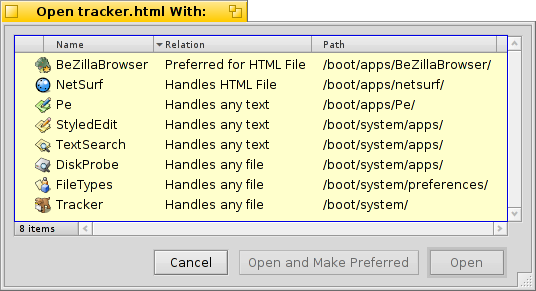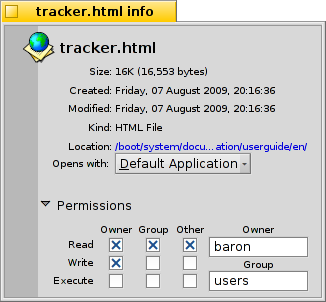| 索引 |
|
挂载磁卷 文件导航 外观设置 首选项 文件处理 传输状态 |
Tracker
Tracker是所有文件的图形界面显示工具。它允许您新建文件和文件夹,复制和删除文件,并且还可以对文件进行查询,启动和重命名等操作。
同其他的应用程序一样 (the Desktop with its icons is really just a fullscreen window in the background),Tracker与它的窗口出现在桌面栏,并且可以关闭和重启。 The easiest way to quit and restart a crashed or frozen Tracker (or a wayward Deskbar) is to call the Team Monitor.
 挂载磁卷
挂载磁卷
为了能够访问硬盘,CD,USB磁盘等,您首先需要挂载这些磁卷,也就是告诉系统,它们存在。 右键点击桌面,或者已经挂载的刺卷(如启动盘),然后从 子菜单中选择磁卷。您也可以在桌面栏中找到相同的 菜单。
还有一个 ,因此你不需要每次启动时都手动挂载所有磁卷。
上述的设置将会自动挂载您所连接/插入的所有存储设备,然后在启动时挂载所有曾经挂载过的磁盘。
 文件导航
文件导航
默认情况下,双击文件夹,Tracker打开新窗口,并且保持先前的打开窗口。这将会很快导致桌面的拥挤。
您可以使用 OPT 键来阻止这种情况发生,它将会自动关闭先前的窗口。
这也同样适用于键盘导航,更多的信息可以参阅主题 快捷键和组合键。
Moving through your folders is one of Trackers main purposes, just like the file managers on other platforms. Haiku's Tracker has some unique features that will help you doing that efficiently.
 进入子菜单
进入子菜单
Instead of double-clicking your way down folder after folder, there's a better way to drill down:
Right-click onto a folder, and at the top of the usual context menu you'll find a submenu of the current folder that let's you navigate down a level. Just move down the hierarchy until you find the file or folder you're looking for and click on it to open it. The above shows the contents of the folder /boot/home/config/.
If you do the above while dragging a file with you, it will be moved to where you eventually drop it.
A similar method can be used from any Tracker window:
Click on the area in the lower left, where the number of items is listed, and you'll get submenus for every level above your current location. From there you can drill down through the folders as usual.
Note, that the Desktop is always the topmost level as that is where Tracker shows mounted volumes. So, if you want to go to another disk, you first have to navigate to the top (Desktop) and cross over to your other disk from there.
You'll get the same submenu-navigating when you drag a file over a folder. After a short while of hovering, a submenu pops up and you can drill down to your destination. If you initiated the drag with the right mousebutton, you can choose between copying, moving or linking the file when you release the mouse.
 Jumping to files with type-ahead
Jumping to files with type-ahead
You may be familiar with the concept from file managers of other operating systems: typing the first few letters of a filename will jump to the first file matching these starting characters. Haiku took the idea a step further. If there isn't a file starting with those letters it will jump to the first file including the string anywhere in its name. And if there's nothing with the string in its filename, the attributes are searched next.
In the above example, there are many files starting with "Haiku logo", rendering simpler approaches to typing ahead quite useless. In Haiku however, typing "web" jumps right to its first occurence in "Haiku logo - website". The characters you enter appear in the bottom left corner where you normally find the item count of all files in the folder. A second after entering a character, the display jumps back to normal and you're ready for a new type ahead search.
 Type-ahead filtering
Type-ahead filtering
Instead of jumping to a file while typing, there's also the option to filter out all files not matching your type-ahead string. This can improve clarity dramatically, especially when dealing with crowded folders. By using SHIFT SPACE as delimiter, you can even filter on multiple strings.
Contrary to type-ahead jumping, the filtering will stick until you press ESC or close the window (or leave the folder if you're using Single Window Navigation).
This type-ahead filtering is set in the Tracker preferences.
 外观设置
外观设置
Tracker windows offer three different viewing modes from the menu:
Icon View (ALT 1) - Big icons, you can change the size from the submenu or in/decrease their size with ALT +/ALT -.
Mini Icon View (ALT 2) - Small icons.
List View (ALT 3) - A detailed list of your files enabling you to show/hide available attributes. (See topic Attributes.)
The menu offers a number of other functions:
Resize Window (ALT Y) - Resizes the window to its ideal size.
Clean Up (ALT K) - Aligns all icons to an invisible grid. Hold down SHIFT and the menu becomes which additionally sorts all icons alphabetically.
Select... (SHIFT ALT A) - Select files according to a regular expression.
Close (ALT W) - Closes the window. Hold down SHIFT and the menu becomes which closes every Tracker window.
Close All in Workspace (ALT Q) - Closes every Tracker window in the current workspace. A useful shortcut if you forgot to hold the OPT key while clicking through folders and all those still open Tracker windows clutter your workspace.
Sometimes you just want to rearrange a few icons without doing a complete (ALT K). In that case, you select these icons and start to drag them to their new location. Before you drop them there, keep ALT pressed. This will align the icons to the invisible grid.
The rest of the functions are pretty self-explanatory, leaving the Tracker preferences.
 首选项
首选项
opens a panel that offers a number of settings that, where not obvious, should become clear once tried out. Since all settings are applied live, you'll immediately see the changes.
So, in short, the not so obvious settings:
Desktop - Decide if all mounted disks appear directly on the Desktop or in a window after clicking a single Disk icon sitting on the Desktop.
Windows - You can set , i.e. a double-clicked folder doesn't open in its own window, but inside the already open window instead, replacing the view of it's parent folder. This is not the same as clicking while holding the OPT key, as described above, because you'll lose the per window saved position and size.

Before you switch Tracker to Single Window Navigation mode, because that may feel more familiar to you, we recommend giving the menu based browsing a try first, as that may actually work much faster for you after getting used to. On the other hand, single window browsing offers a Navigator where you can enter or copy&paste a path name and use back, forward and up buttons.
Activating will filter the contents of a Tracker window while you type to only display the files matching your string in their name or any currently displayed attribute. See above.
Date and Time - Set date and time formats.
Trash - Set the behavior when deleting a file.
Volume Icons - Set the color of an optional indicator of free space that's shown besides a disk's icon.
This panel, by the way, is also available as Tracker from Deskbar's .
 文件处理
文件处理
When invoked on a selected file, most of the menu commands are also offered in the context menu by right-clicking that file.
As usual the commands are pretty clear.
Find... - Find a file or folder. See topic Query for more info.
New - Create a new folder or any other file based on a template.

Choosing opens the folder /boot/home/config/settings/Tracker/Tracker New Templates. Creating a file in that folder will offer its filetype with the file's name and other attributes as template in the menu. Here, there's a file "Text" with the filetype text/plain. See topic Filetypes for more info.
Open With... - A submenu offers all applications that can handle this filetype.

The preferred application that would open the file when double-clicked, is checkmarked. This submenu lists first those applications that can handle the exact filetype, in this case it's a text file, the type text/plain. Next come all applications that can handle that supertype in general, here text/*. Last in the list are those that can deal with any file. If you don't click on an app in the submenu, but on the entry instead, a panel opens:

Here you'll again find the programs that were listed in the submenu. By selecting one and clicking the button, you changed the preferred application for every file of that filetype, here text/plain.
- Get Info

The panel presents info on the selected file and lets you set the default application and, after you expanded that part of the panel, permissions and owner. Clicking on the path will open it in a Tracker window.
Edit Name, Duplicate and Move to Trash - lets you rename or duplicate a file or put the selected file(s) to the trash.
Move to, Copy to and Create Link - lets you move, copy or link the selected file(s) using the submenu navigating method. Holding SHIFT while invoking the menu offers the option to create a relative link.
Cut, Copy and Paste - lets you cut, copy and paste files using the clipboard. By holding SHIFT while invoking the menu you can Copy/Cut more files, maybe from another folder that you can paste somewhere else later. Also, while holding SHIFT you can paste the copied files in the clipboard as links.
Identify - will sniff out and set the type of files if they didn't have one before, e.g. if you transferred a file with wget which doesn't set a filetype itself. Holding SHIFT while invoking the menu changes the item to Force Identify which identifies the filetype and corrects it if it was false before.
Add-Ons - offers you every generic Tracker add-on and those that can handle the selected file(s). See topic Tracker Add-ons for more information.
 传输状态
传输状态
When you copy, move or delete files, Tracker shows its progress with a status window. If you initiate more than one transaction, each job gets its own status display.
To the right are two buttons to pause or stop a transaction entirely. Sometimes it can be useful to temporarily pause a large transaction. For example, you may need to quickly launch a large application. Copying large amounts of data chokes your harddisk's IO bandwidth and thus delays your workflow.
 中文 [中文]
中文 [中文] Français
Français Deutsch
Deutsch Italiano
Italiano Русский
Русский Español
Español Svensk
Svensk 日本語
日本語 Українська
Українська Português
Português English
English